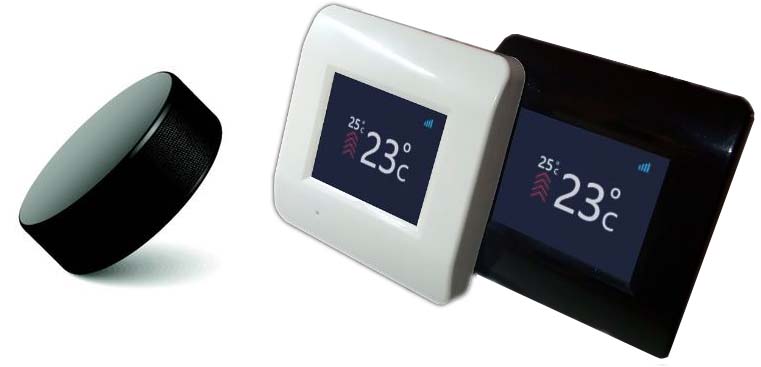
Lyrical digression
In my opinion, in today's Russia, two types of projects have the greatest chances of success in the field of technology startups:
However, the article is devoted to the analysis of a completely different kind of product. In such developments, technical problems are not even secondary, but are relegated to the tenth plan. The vast majority of startups do not die at all due to technical problems. They are ruined by a lack of demand, a lack of competitive advantages, an unfinished business model, and poor financing.
You can’t imagine how annoying it is when looking at how the founders put money and time into the furnace of startups. Especially when the idea is good, but it is killed by repeated mistakes over and over again. Many people prefer to learn from mistakes, but it's better to do it all the same from strangers.
- narrow niches in the field of industrial automation, founded by a team of professionals in this field and backed up with start financing of at least 20 - 50 000 USD
- prototyping devices targeting global markets
However, the article is devoted to the analysis of a completely different kind of product. In such developments, technical problems are not even secondary, but are relegated to the tenth plan. The vast majority of startups do not die at all due to technical problems. They are ruined by a lack of demand, a lack of competitive advantages, an unfinished business model, and poor financing.
You can’t imagine how annoying it is when looking at how the founders put money and time into the furnace of startups. Especially when the idea is good, but it is killed by repeated mistakes over and over again. Many people prefer to learn from mistakes, but it's better to do it all the same from strangers.
I have long wanted to conduct a detailed analysis of a project for the development of electronics, to show obvious errors and the right approaches that will help to eliminate them. Perhaps it would have been going for a long time, but the case turned up - a post on the Habra blogosphere “The formation of a thermostat. How did it happen . ” The article caused a storm in the comments
Let's try to audit the project
A bit of circuitry
A couple of paragraphs about “children's” mistakes
Moving from experiments with Arduino sets of compatible boards to designing real devices, novice circuit designers themselves, without suspecting it, sometimes make “children's” mistakes. They tend to simplify custom design by removing “unnecessary” details from it, the meaning of which they do not understand, or non-observance of even basic trace rules. When, as a result, the circuit completely refuses to work, this is still half the trouble. It is much worse if its unstable work is observed. For an adequate analysis of circuitry, there is a lack of knowledge and experience, as a result, hardware problems are often tried to “heal” with software crutches. If this does not help, time and money are spent on finding the right solution using the pseudo-scientific poke method.
In the case of a DIY project, this is not too scary. Step by step, on one’s own mistakes, a person gains experience. Saving during the commercial project on professionals and even an independent audit of the project is fraught with serious loss of valuable time. Years of Sisyphean labor are wasted and often everything ends sadly. Either the team “burns out” from constant failures and the team crumbles, or the idea loses its relevance.
In the case of a DIY project, this is not too scary. Step by step, on one’s own mistakes, a person gains experience. Saving during the commercial project on professionals and even an independent audit of the project is fraught with serious loss of valuable time. Years of Sisyphean labor are wasted and often everything ends sadly. Either the team “burns out” from constant failures and the team crumbles, or the idea loses its relevance.
The materials laid out in the article contain too little information on the basis of which one can conduct a qualitative analysis of circuitry and circuit boards. Perhaps we were generally presented with outdated board options. But even if this is so, the analysis will be useful not so much for the authors of the project as for the readers.

With a high degree of probability, it can be argued that the frequent “hangs” of the ESP module are associated not so much with its “glitchiness” as with serious problems in the power supply system. An attempt to get out of the situation by introducing an external dog, is similar to treating a patient with fever by immersion in a bath of cold water. In the short term, the result will be achieved, but such treatment will most likely end in death.
Small-sized high-quality AC-DC modules from well-known manufacturers cost a lot of money and “undermine” the economics of such projects even more than “sophisticated” graphic indicators with a touch screen. You can understand why it is difficult for novice developers to overcome the temptation to develop a switching power supply independently and quickly. In DIY projects, such attempts often end in a light, but long memorable, electric shock and a small firework. To risk in a similar way in commercial development is too dangerous and in this case I consider the installation of a purchased module justified, but the question of its choice remains open.

In this project, we are dealing with an extreme case - an inexpensive, small-sized, reliable power source is needed for the controller. But most importantly, it should provide suppression of significant impulse noise caused by relay switching of high power loads. There is a wide selection of AC-DC power supply modules on the market, the passport data of which are very similar, and the price is different at times. There is every reason to believe that not only due to brand margins.
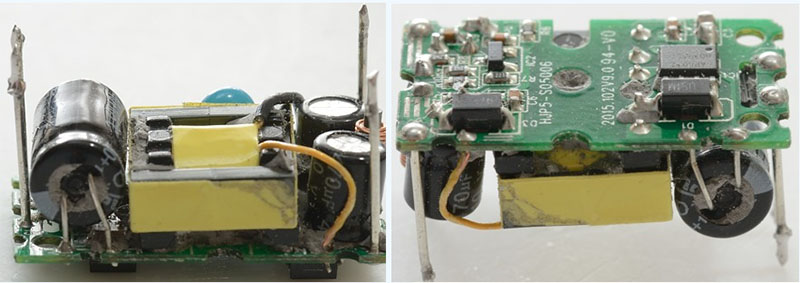
A visual study of the insides of the cheapest of the three modules shows that a large number of manual operations were used to create it. This reduces the repeatability of installation and increases the likelihood of marriage. You can “lay” such modules into the specification of a serial product only after thorough testing of several copies from different lots, reverse engineering and analysis of circuitry. In addition, one hundred percent control will be required before installation, and you won’t get away with simply measuring the output voltage. We will have to create an automated stand for 100% control of these products under load and in the condition of impulse noise. So, choosing an extremely cheap option, you need to weigh everything seven times.
Lyrical digression about the dangers of extremely cheap solutions
The cost of a high-quality small-sized AC-DC module exceeds 10 USD. Such a high price makes many beginner circuit designers look for cheaper solutions and, at times, they turn their eyes to modules without galvanic isolation, similar to those shown in the figure below.

The authors of the project did not succumb to this temptation and were absolutely right. Do not do this to the rest. Such designs can be life threatening, and the likelihood of their successful certification tends to zero. If even this does not stop you, then it is necessary to approach the circuitry of such a power source with special care. For example, the circuit shown above has significant drawbacks. When it is connected to an alternating current network at the time of the maximum potential difference - more than 300 volts, a large pulse current will appear in the circuit D1 - C1, which can lead to failure of the diode D1. After failure, diodes most often turn into a conductor, through which alternating current flows to the electrolytic capacitor. This will end with an explosion, a spray of electrolyte and white puffs of smoke, which with a terrible stench will fall out of your device. I note that neither the varistor, nor the current-limiting resistor R1, nor the fuse, in this circuit, are protection against this scenario. You can of course put a diode with a large allowable current, but then C1 can fail with a working diode from a large pulse current at the time of switching on.

The authors of the project did not succumb to this temptation and were absolutely right. Do not do this to the rest. Such designs can be life threatening, and the likelihood of their successful certification tends to zero. If even this does not stop you, then it is necessary to approach the circuitry of such a power source with special care. For example, the circuit shown above has significant drawbacks. When it is connected to an alternating current network at the time of the maximum potential difference - more than 300 volts, a large pulse current will appear in the circuit D1 - C1, which can lead to failure of the diode D1. After failure, diodes most often turn into a conductor, through which alternating current flows to the electrolytic capacitor. This will end with an explosion, a spray of electrolyte and white puffs of smoke, which with a terrible stench will fall out of your device. I note that neither the varistor, nor the current-limiting resistor R1, nor the fuse, in this circuit, are protection against this scenario. You can of course put a diode with a large allowable current, but then C1 can fail with a working diode from a large pulse current at the time of switching on.
It's time to take a closer look at the photos of the boards laid out by the author.
Even in the scant documentation we have at our disposal, there is food for analysis.

We will not find fault with the choice of the type of interface connector, because we have a prototype, and I'm sure that in the real device there will be something more reliable. The location on the board and the very presence of a temperature sensor inside the housing are
Much more disturbing is my right photo, which shows design elements of high-voltage high-current circuits.
For comparison, below are photos of the insides of the popular Chinese Sonoff wireless relay module, controlled via WiFi, with a sub-GHz submodule on board.

The miracle of price optimization in China seems more prepared for operation and certification than our “defendant”. In it, one thing confuses me - the terminal block is too small in size for currents of 10 amperes. But the Chinese device is optimized in performance for switching lighting. But “ours”, by definition, should work with high currents, for which it has a relay of as much as 16 Amps. I hope that the relay is selected to the proper quality and its contacts will not “stick” after a couple of months of operation, but as for the long and happy operation of the terminal block at such currents, I have serious doubts, although the copper conductors inserted into it must be the minimum diameter (1.5 mm) most likely it will work out. Personally, I, at least for high-current circuits, would have hammered into the specification the terminal blocks of a well-established manufacturer, for example, WAGO or Weidmüller, which is a very important part that you should not save on. Having carefully looked, you can see the tricky cuts in the Chinese version (number 2). If the author of domestic design believes that they are needed for weight loss, then he is deeply mistaken. They prevent carbonization of the section of the board between two printed conductors with a large potential difference due to breakdown. Breakdown is an extremely unpleasant thing. It is good if one of the tracks or a fuse simply burns out due to the arcing of an electric arc. And if a fire starts? Especially often, such troubles occur in high-voltage DC circuits - between them, due to the polarization effect, dust likes to accumulate, and with increased humidity ...
The only significant detail on which our Chinese partners allowed themselves to save is the capacitor, the role of which is to suppress pulsed interference.
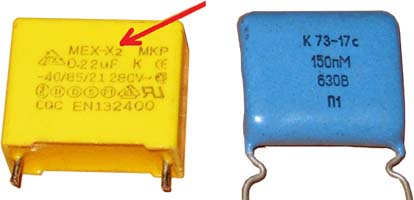
We will not go deep into details, we only note that for this it is worth using specially designed capacitors that can absorb short surges with voltages up to 2500 Volts. Those intended for domestic use are marked X2.
 As a rule, when such capacitors fail, a short circuit occurs between them. In the circuit, the current rises sharply and either the fuse or the inductor burns, which often put the fuse in place. As a result, the device, which has become dangerous to human life, goes out of operation.
As a rule, when such capacitors fail, a short circuit occurs between them. In the circuit, the current rises sharply and either the fuse or the inductor burns, which often put the fuse in place. As a result, the device, which has become dangerous to human life, goes out of operation.
If you decide to use more low-cost capacitors that do not contain such a marking, you must make sure that the maximum allowable voltage on them is at least 600 volts and they are suitable for operation in pulsed circuits, like the one on the right.
Let us return to the published section of the floor heating controller circuit.

It seems that there is also a capacitor for suppressing impulse noise and the AC-DC module is similar to galvanically isolated ... Unfortunately, we are not able to see what is hidden under the top board. There probably should be an AC-DC module, but you can only guess about the type of left capacitor in the circuit. If it is chosen incorrectly, then the abundance of electrolytes is not able to provide the required level of suppression of impulse noise, and this, in turn, can most negatively affect the stability of the WiFi module.
With this, by force, I finish the story about circuitry and move on to a more important topic, for which the article was written - product development and marketing.
Talk about the eternal - values
So, you conceived your product. I hope it has unique properties. The more significant these differences are, the more seriously you stand out from the competition, which means you attract attention. But there is one caveat. Differences can both attract new customers and repel.
 Suppose you invented a bucket in which the bottom is full of holes. Most people use a bucket to carry and store liquids. Their purchase of your innovative bucket will infuriate you. But there is a man who guesses to use it in order to sift sand from stones or as a shower. He will be very pleased with the presence of holes. The problem is that it will be only one buyer per 1000, or maybe 10000, those who use buckets for their traditional purpose.
Suppose you invented a bucket in which the bottom is full of holes. Most people use a bucket to carry and store liquids. Their purchase of your innovative bucket will infuriate you. But there is a man who guesses to use it in order to sift sand from stones or as a shower. He will be very pleased with the presence of holes. The problem is that it will be only one buyer per 1000, or maybe 10000, those who use buckets for their traditional purpose.
We draw conclusions: In the process of product development, functionality does not make sense in isolation from the audience of users for whom it is of value. For this reason, at the earliest stages, you should determine the circle of consumers for whom your device may be useful. It is necessary to approach this with special care - to find out their addictions, way of thinking, property status and most importantly, how important your problem can be for your product to help solve it and why it does it better than existing ones.
Consumer analysis. Budget sector
Let's try to outline the circle of potential consumers of our thermostat and the trends that affect their change.
In the private sector, it’s a little expensive to heat electricity, so the first thing we are interested in is buyers of new apartments and secondary real estate. It is easiest to make money in a growing market, but today we have the opposite picture.
a bit of macroeconomics
The country has been in a permanent crisis for six years. The incomes of the population have been falling for six years, only in the last year the economy began to grow, but, firstly, with an error close to  statistical, and secondly, there is every reason to believe that the only driver of growth is the constant revision of Rosstat methods. We will not go into details further, we will take for the fact that there is no growth and in the future the hope for its renewal is vague. The real estate market is stagnating. Apartments are sold, but the percentage of those who take them on a mortgage is constantly increasing, while the initial payment is constantly falling along with the area of the apartments. Studios of 11 square meters appeared in Moscow and this is not the limit! The likelihood that buying a studio with a bathroom area of 2 square meters. meter and standing in the mortgage for 20 years, a person first of all will take a consumer loan for overhaul and arrangement of underfloor heating in his favorite toilet, of course is different from zero, but not too much.
statistical, and secondly, there is every reason to believe that the only driver of growth is the constant revision of Rosstat methods. We will not go into details further, we will take for the fact that there is no growth and in the future the hope for its renewal is vague. The real estate market is stagnating. Apartments are sold, but the percentage of those who take them on a mortgage is constantly increasing, while the initial payment is constantly falling along with the area of the apartments. Studios of 11 square meters appeared in Moscow and this is not the limit! The likelihood that buying a studio with a bathroom area of 2 square meters. meter and standing in the mortgage for 20 years, a person first of all will take a consumer loan for overhaul and arrangement of underfloor heating in his favorite toilet, of course is different from zero, but not too much.
The Moscow renovation will certainly make its contribution to a further decrease in the living space of apartments.
 statistical, and secondly, there is every reason to believe that the only driver of growth is the constant revision of Rosstat methods. We will not go into details further, we will take for the fact that there is no growth and in the future the hope for its renewal is vague. The real estate market is stagnating. Apartments are sold, but the percentage of those who take them on a mortgage is constantly increasing, while the initial payment is constantly falling along with the area of the apartments. Studios of 11 square meters appeared in Moscow and this is not the limit! The likelihood that buying a studio with a bathroom area of 2 square meters. meter and standing in the mortgage for 20 years, a person first of all will take a consumer loan for overhaul and arrangement of underfloor heating in his favorite toilet, of course is different from zero, but not too much.
statistical, and secondly, there is every reason to believe that the only driver of growth is the constant revision of Rosstat methods. We will not go into details further, we will take for the fact that there is no growth and in the future the hope for its renewal is vague. The real estate market is stagnating. Apartments are sold, but the percentage of those who take them on a mortgage is constantly increasing, while the initial payment is constantly falling along with the area of the apartments. Studios of 11 square meters appeared in Moscow and this is not the limit! The likelihood that buying a studio with a bathroom area of 2 square meters. meter and standing in the mortgage for 20 years, a person first of all will take a consumer loan for overhaul and arrangement of underfloor heating in his favorite toilet, of course is different from zero, but not too much.
The Moscow renovation will certainly make its contribution to a further decrease in the living space of apartments.
It is not necessary to count on recipients of mortgages with a minimum initial payment. In conditions of falling incomes, they are not up to “warm floors”.
In the budget segment, we have no one to catch, we turn our eyes to the middle class.
Consumer analysis. Middle class
a bit of macroeconomics
The middle class in Russia is shrinking and becoming poorer. At the same time, its social composition is changing. Many entrepreneurs operate at a loss or minimum margin. Those to whom  luckier, they are increasingly turning their eyes to foreign real estate, considering investments in it more reliable, and most importantly, promising. Fertility is falling, and with it falling demand for large apartments. In the Moscow region, demand for suburban homes / summer cottages is collapsing due to traffic jams that are only increasing due to the emergence of ever new urban-type settlements beyond the Moscow Ring Road, overloading the transport system, especially during peak hours.
luckier, they are increasingly turning their eyes to foreign real estate, considering investments in it more reliable, and most importantly, promising. Fertility is falling, and with it falling demand for large apartments. In the Moscow region, demand for suburban homes / summer cottages is collapsing due to traffic jams that are only increasing due to the emergence of ever new urban-type settlements beyond the Moscow Ring Road, overloading the transport system, especially during peak hours.
However, there are factors that play a plus. The segment of the supernova Middle Class is expanding due to an increase in the income and number of officials, Church Ministers, people in uniform and berets with the right to wear balaclava in public places.
 luckier, they are increasingly turning their eyes to foreign real estate, considering investments in it more reliable, and most importantly, promising. Fertility is falling, and with it falling demand for large apartments. In the Moscow region, demand for suburban homes / summer cottages is collapsing due to traffic jams that are only increasing due to the emergence of ever new urban-type settlements beyond the Moscow Ring Road, overloading the transport system, especially during peak hours.
luckier, they are increasingly turning their eyes to foreign real estate, considering investments in it more reliable, and most importantly, promising. Fertility is falling, and with it falling demand for large apartments. In the Moscow region, demand for suburban homes / summer cottages is collapsing due to traffic jams that are only increasing due to the emergence of ever new urban-type settlements beyond the Moscow Ring Road, overloading the transport system, especially during peak hours.
However, there are factors that play a plus. The segment of the supernova Middle Class is expanding due to an increase in the income and number of officials, Church Ministers, people in uniform and berets with the right to wear balaclava in public places.
Despite the fact that the size of the middle class is decreasing, due to its re-segmentation, the
Consumer analysis. Elite demand
It existed and will exist in our country, well, at least until the oil runs out. However, there is every reason to believe that the patriotic attitude of the majority of representatives of this group weakly stimulates demand for the products of novice Russian entrepreneurs in the field of home life support systems. With a high degree of probability, they will turn their eyes to well-known Western brands in the upper price range, at least for reasons of prestige.
Consumer analysis. To summarize
- The fastest growing segment Supernova middle Russians - a growing segment of the middle class - officials, employees of power structures of all stripes, clergy.
- Slowly growing segment Highly qualified specialists, primarily in the field of
- Falling demand Small and partly medium-sized entrepreneurs.
We build value hypotheses

The first segment has the most solvent demand, part of which can be competed by competing with well-known western brands. When organizing sales, it should be borne in mind that this is a very specific audience. Products sold to her should have the following qualities: expressive and diverse design. People who “raise” their status quickly, with extremely high self-esteem, can have the most unexpected “ideas about the beautiful” and are ready to pay for their implementation. The ability to customize their appearance is important to them to a large extent. The interface must be as simple as possible, designed to switch several preset modes. Unusual features are appreciated. Reliability of work and the fastest level of service is very important, otherwise you can get very big troubles instead of profit.
The second segment is ready to pay primarily for high functionality, even if it never takes advantage of it. For IT professionals, software flexibility and the availability of an open API for integration with smart home systems from other manufacturers will be a big advantage.
Third segment For the most part pragmatics. First of all, good basic functionality with default settings, ease of management and design that fit into the “calm” interior of the room are important.
Looking for competitive advantages
If you do not have competitive advantages, then the costly operation of creating a new product does not make the slightest sense. Buy existing devices on the market and focus on sales and software development for them.
 To find additional competitive advantages, you can try to use a scientific approach. There is an excellent technique based on building a “strategic canvas”. The book “The Blue Ocean Strategy” is devoted to this technique, and an example of its application to determine the functionality of a new electronic product can be found in one of my previous articles on Habr.
To find additional competitive advantages, you can try to use a scientific approach. There is an excellent technique based on building a “strategic canvas”. The book “The Blue Ocean Strategy” is devoted to this technique, and an example of its application to determine the functionality of a new electronic product can be found in one of my previous articles on Habr.
Within this article, there is not enough time for a full-fledged study, so we will be guided by the logic, experience and valuable advice prompted in the comments.
Based on the circle of consumers that we have identified for ourselves, it becomes clear that there is no point in trying to fight for a super-budget niche - there is weak, and most importantly falling, solvent demand. Leave it to the Chinese magicians and will think further.
The most demanding consumer qualities of the product are the buyers of the first segment. We will focus on them in the first place. What is needed in order to satisfy them:
- The most simple user interface
- Several operating modes for the most standard cases with carefully thought-out default settings
- “Solid appearance”, which at the same time is unusual and can be customized for the user.
- Extremely reliable operation even in conditions of a significant deviation of the mains voltage from the nominal value and serious interference caused by poor quality wiring. Any failure of equipment from such customers is fraught with very big troubles.
 The product qualities described above will not be superfluous also for conditional “IT employees”. However, they can be presented with an additional serious bun in the form of an open API, with the help of which they can realize their fantasies in controlling the device and combine it with the components of their “smart home” that already exist in them.
The product qualities described above will not be superfluous also for conditional “IT employees”. However, they can be presented with an additional serious bun in the form of an open API, with the help of which they can realize their fantasies in controlling the device and combine it with the components of their “smart home” that already exist in them.
How to realize all this?
What to do with appearance? We’ll make 10 housing options and pay 5 kiloevs for each mold, print 500 thousand cases of different shades and
 sell them before the loan day?
sell them before the loan day?
Not the best solution
And why not ask for help from the Auditorium? .. If you carefully read the comments on the article, then on the basis of only two you can get recommendations for solving the problem. At least for the next iteration.
So, the top 1 in my ranking is a comment from a respected lingvo.
He deserves to be quoted verbatim.

The second most valuable comment from the no less worthy zapimir habrayuzer and it is located very close.

Of great value is another excerpt from the commentary of the same habrozer.
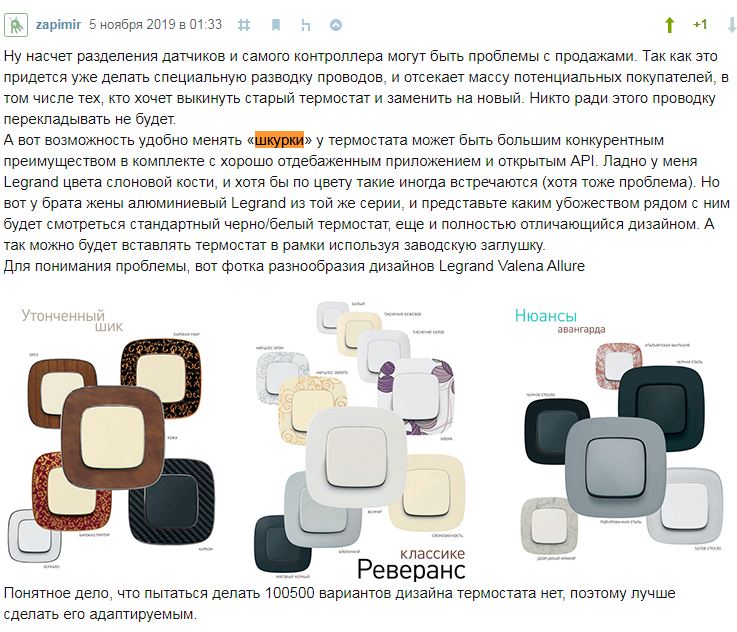
Only two people were able to tell us the way, which is worth moving!
Let's try, taking into account their comments, to create a new iteration of the device concept.
Divide and rule
Wireless Modules
 The main change - we switch to a distributed system - we divide the device into parts, combining them with a wireless interface.
The main change - we switch to a distributed system - we divide the device into parts, combining them with a wireless interface.
The right choice of interface type and radio frequency range is the cornerstone task on which the success of a project depends.
At first glance, the sub-gigahertz range of 868 MHz is the best solution. Waves of this frequency are much lighter than their higher frequency counterparts, overcome the obstacles of propagation in the form of drywall panels and even reinforced concrete floors. In addition, today, in this range, there are much fewer devices than at
 2.4 GHz.
2.4 GHz.
However, I would opt for transceivers with support for Bluetooth Low Energy (BLE), which operate in the 2.4 GHz band. This range is heavier loaded, however, this solution has many serious advantages:
- The number of working channels is much higher
- The BLE standard has mechanisms for automatically “jumping” from channel to channel to offset interference
- In the fifth version of the protocol, support for distributed self-organizing MESH networks appeared, which allows building additional heating control systems not only within large-area apartments, but also in cottages without additional network extenders
- The BLE standard is ideal for creating sensors and other extremely low-power devices that can run on the same battery pack for several years.
- If necessary, modules with increased power sensitivity can be used.
It makes no sense to independently design a wireless communication channel - with small volumes of purchases, the equipment will cost more than the purchase of ready-made modules of decent manufacturers. Moreover, having no experience with RF components and specialized measuring equipment, it is difficult to count on a good result.
Wireless relay
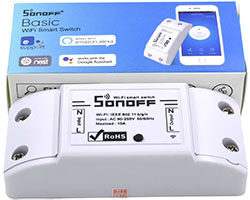 We control the contact groups of the “underfloor heating” relay with a separate device that does not have its own display and controls. It is carried out in the standard purchase case. At the first stage, it is worth considering the feasibility of using a fully ready-made commercially available device. In the future, upon reaching serious volumes, it is possible to develop your own, designed taking into account operating experience during initial sales.
We control the contact groups of the “underfloor heating” relay with a separate device that does not have its own display and controls. It is carried out in the standard purchase case. At the first stage, it is worth considering the feasibility of using a fully ready-made commercially available device. In the future, upon reaching serious volumes, it is possible to develop your own, designed taking into account operating experience during initial sales.
The supplier must be selected carefully, preferably already having a Russian certificate.
At the initial stages, it is possible to use a purchased wireless electronic relay module, but it is necessary to approach its selection and testing with great care. The main plus of this decision is that you don’t have to spend money on developing a power source and certification. The second - for the troubles associated with high voltage and current circuits, the manufacturer of the purchased device is responsible. It is advisable to find a device that has the same wireless chip on board that is taken as the basis of the project. It will be possible to reflash it with your code.
Sensors
Modern BLE chips are based on microcontrollers with an ARM4 core and have a rich enough periphery for implementing various sensors and more complex devices without the use of an additional microcontroller.
To create wireless sensors, you need to add to the board with the BLE module one of the sensor chips that can measure temperature and pressure, for example, as I described in a previous article on Habr.
In order for such a device to work autonomously for several years, one three-volt CR2032 battery is enough.
To save money, several types of sensors can be bred on one board at once and, if necessary, installed on one board or another peripheral.

- humidity / temperature sensor
- leak detector
- contact sensor
- inertial sensor
Hub
BLE is good, but it doesn’t provide Internet access. We’ll have to think about a hub that will become a bridge between BLE and WiFi. There are probably not many options here. WiFi based on any of the ESP modules, better than the modern type of ESP32. BLE module, in addition to performing basic
 functions, can monitor the correct operation of the WiFi module and reboot it if necessary. Theoretically, the latest generation ESP 32 chip can work both in WiFi mode and in BLE mode, but I would not risk making a router solely on its basis.
functions, can monitor the correct operation of the WiFi module and reboot it if necessary. Theoretically, the latest generation ESP 32 chip can work both in WiFi mode and in BLE mode, but I would not risk making a router solely on its basis.
The device receives power through a microUSB (USB3 typeC) connector, has a built-in battery for autonomous operation, a sound emitter for warning of an emergency and a seven-segment LED emitter for several discharges, hidden under the frosted glass.
Design Details
Let's try to save on the case. This will be extremely useful when organizing the first sales in small batches. It can be done in a fashionable now minimalist design - in the form of a puck. The base of the ring, which is obtained by cutting like a sausage tube. We install a translucent plastic cover on top. Below is the second cover, to which,
Xiaomi sensors are similar, but much more complicated. With their production volumes, making a molding for the manufacture of the upper part of the body of complex shape is not a problem.
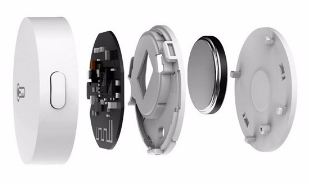
All devices except the relay module can be executed in this form factor. At the first stage there will be enough cases of two sizes. More for hubs, less for sensors.
Such a case is good in that, having a stylish appearance, it is very easy to manufacture in small batches and for customization. You do not need any 5000 USD per mold. Tube cutting is a simple and cheap operation, cutting plastic sheets as well.
HOW TO SATISFY EVERYTHING AND IMMEDIATELY
Each star has its own piece of heaven,
Each sea has a sip of rain.
Each apple has a place to fall,
Each thief has an opportunity to steal,
Each dog has a stick and bone,
And each wolf has teeth and anger
As a result of our research, we got the concept of a convenient and flexible device. There is only one problem - we’ll enter the market late in the day. Today, not only nameless Chinese firms, but also global corporations are following the same path. One of the most serious competitors is the brainchild of Philips - a series of devices manufactured under the common brand “Xiaomi”. To compete with them, one must look for serious advantages.
A company with low resources entering a falling market does not have many trump cards up its sleeve. It is necessary to concentrate on related services and a simple installation procedure.
Boxed versions for budget buyers

The ability to choose from several standard versions in which:
- the supplied devices are already connected to each other. Take it out of the box and get started
- well thought out several default configurations to choose from
- all you need to do to work with the boxed version is to download and install the mobile application, go to the server at the specified address, scan the barcode on the box and enter the password. After that, you find yourself on a profile that is already configured under the devices in your box and select one of the operation scenarios.
- “ ”
- , , ,
,

- , ,
- . :
- the manufacture of linings from non-standard materials, up to semiprecious stones (for this, you can involve craftsmen from service rendering services, for example, from profi.ru
- Sales option with installation and configuration. Installation can be combined with delivery, and can be performed separately. Here you need to weigh the pros and cons.
IT specialists
Since among the clients we specially singled out those who are familiar with IT technologies firsthand, we will prepare buns for them. This is of course an open API with great features for customization and integration into other systems.
Third-Party IOT Projects
If the project is successful, an open API and assistance in customization can attract developers of individual devices in the field of IOT, who fully reveal their capabilities as part of complete systems.
Time to take stock
Our small study strongly resembles a brainstorm, which resulted in a host of hypotheses awaiting verification. It will be extremely difficult for start-ups to develop simultaneously in all the areas outlined, therefore it will be necessary to choose the most promising ones, test, switch to others ...
In conditions of extremely limited resources, in weakly growing or falling markets, this is also difficult with purely software startups, and in the case of a hardware product almost impossible. Creating a commodity device on your own savings is extremely difficult even with a unique idea.
The size of the article did not allow us to discuss possible steps that need to be taken for promotion and PR. Hopes solely on word of mouth in most cases are completely unfounded.
Perhaps I will touch upon these problems next time if the article arouses interest ...
Instead of an afterword

If you have done what no one has done before you, then perhaps you are a Genius. But much more often the reason is more prosaic - just anyone but you does not need it. Large companies spend millions of dollars studying demand. A similar reaction to free comments and suggestions from the target audience is nonsense.
You must be able to separate flies from cutlets. If you do something solely for the sake of getting high, it is certainly commendable. Only this is called the word DIY and is not always scaled as part of a startup.
If you are developing a device as part of a commercial project, it should be borne in mind that creating a successful product without feedback from potential customers and experts is almost impossible. In today's world, the one who knows how to use it in the best way is on a horse.
A huge request to read to the end to complete the survey